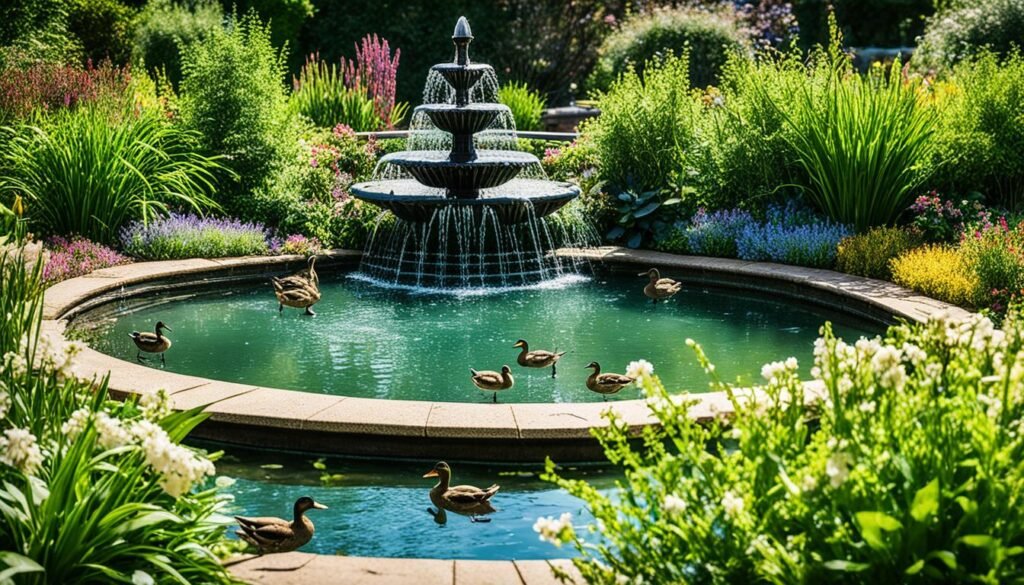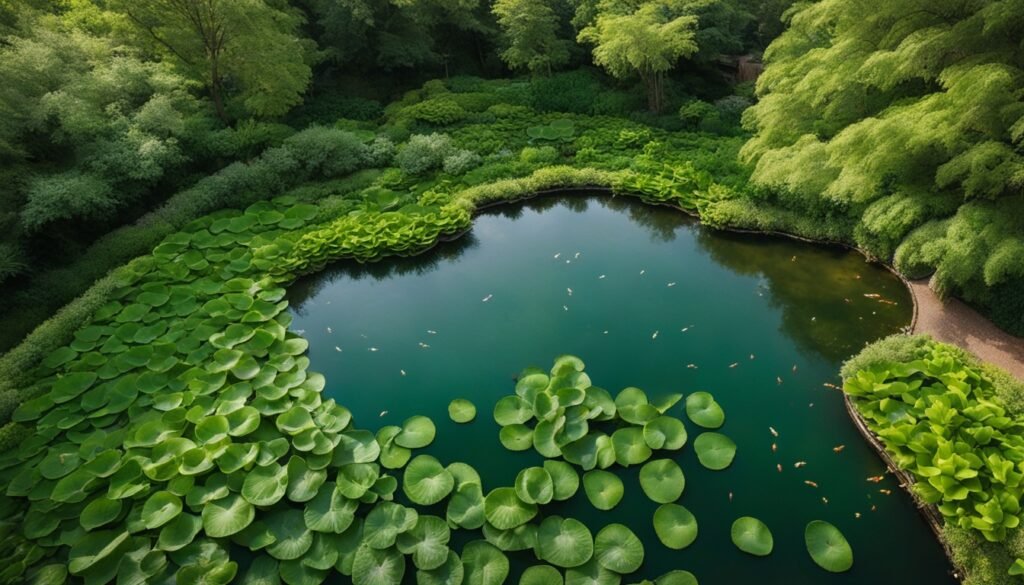Ever pondered why your duck pond seems to get dirty quicker than you can clean it? I’ve been in your shoes, grappling with the challenge of keeping a waterfowl habitat spotless. Duck pond upkeep can be complex, yet achievable with the correct strategies.

My insights suggest that the secret to maintaining duck pond water quality hinges on grasping the nature of our feathered companions. Ducks, being messy eaters and swimmers, disturb the sediment and deposit waste, making waterfowl pond cleaning a distinct challenge.
However, there’s no need to despair! I’ve unearthed some straightforward tips and tricks to aid in the upkeep of your duck pond’s cleanliness and health. We’ll delve into natural remedies and structural enhancements that ensure a thriving aquatic setting for your ducks.
Understanding Duck Pond Maintenance Challenges
Maintaining a duck pond is a complex endeavor. These water features, though charming, pose unique challenges. Managing duck behavior and pollutants requires meticulous planning and consistent effort.
Duck Behavior and Water Quality
Ducks, though delightful, can significantly impact water quality. Their constant introduction of debris and waste leads to rapid accumulation in the pond. This organic matter decomposes, increasing nutrient levels and potentially causing harmful algae blooms. Thus, effective water treatment is vital.
Common Pollutants in Duck Ponds
Duck ponds encounter various pollutants that threaten water quality. These include:
- Excess nutrients from duck waste
- Algae overgrowth
- Organic matter from fallen leaves and plants
- Sediment from erosion
Regular sludge removal is crucial to manage these pollutants and sustain a healthy ecosystem.
Balancing Aesthetics and Cleanliness
One major challenge is balancing the pond’s natural beauty with cleanliness. It’s essential to manage pollutants without compromising the pond’s appearance. This involves strategic plant placement, erosion control, and the selective use of filtration systems. By tackling these issues, we can maintain a duck pond that’s both aesthetically pleasing and healthy.
How to Keep a Duck Pond Clean: Essential Strategies
Keeping a duck pond clean is a challenge, but certain strategies can make it easier. Let’s explore the key methods for maintaining a pristine and healthy pond.
Implementing effective filtration systems
Filtration is vital for water quality in a duck pond. I’ve found that using pond skimmers and drains creates an efficient system. This setup removes debris and ensures water circulation, preventing stagnation. To enhance clarity, I incorporate ultraviolet clarifiers. These devices eliminate floating algae cells and microscopic bugs, resulting in crystal-clear water.
Utilizing bacterial pond cleaners
Bacterial pond cleaners are essential for managing organic buildup. These microbes break down decomposing matter, lowering nutrient levels that algae thrives on. I regularly add them to the pond to maintain a balanced ecosystem and avoid water quality problems.
The barley straw method for algae control
The barley straw method is a natural way to control pond algae. It’s straightforward and effective. As the straw decomposes, it releases a substance that hinders algae growth. I add about 15 grams of barley straw per square meter of pond surface. This approach keeps my pond clean without the need for harsh chemicals.
| Cleaning Strategy | Benefits | Application Rate |
|---|---|---|
| Filtration System | Removes debris, improves circulation | Continuous operation |
| Bacterial Cleaners | Reduces organic matter, prevents stagnation | Weekly application |
| Barley Straw | Natural algae control, eco-friendly | 15g per square meter |
By employing these strategies, I’ve successfully maintained a clean and healthy duck pond all year. It’s a fulfilling process that creates a beautiful environment for ducks and other wildlife.
Natural Solutions for Clearer Water
Nature often offers the best solutions for maintaining clean duck ponds. By introducing the right plants and animals, you can foster a thriving ecosystem. This ecosystem will help keep your pond water clear naturally.
Introducing Beneficial Aquatic Plants
Duck pond aquatic plants are vital for water quality. Water lilies are my preferred choice for controlling algae growth. They cover the pond surface, reducing sunlight penetration. I suggest covering 50-70% of your pond with lilies for optimal algae control.
Other beneficial plants include water hyacinth and, which absorb excess nutrients from the water.

Employing Natural Scavengers and Filter Feeders
Nature’s clean-up crew can significantly improve your duck pond. Snails, tadpoles, and freshwater mussels have been highly effective for me. These creatures eat waste and filter the water, ensuring clarity.
Clams are another excellent choice, acting as natural water purifiers.
Creating a Balanced Ecosystem
A balanced ecosystem is crucial for a healthy duck pond. Proper aeration is essential for this balance. It increases oxygen levels, supporting beneficial bacteria that break down waste efficiently.
Solar aerators are a great option, especially in colder climates. They prevent ice formation, offering a safe space for ducks from predators.
By integrating these natural solutions, you’ll establish a self-sustaining ecosystem. This ecosystem will keep your duck pond clean and clear throughout the year.
Structural Improvements for Duck Pond Maintenance
Enhancing your duck pond’s structure can greatly improve its upkeep and health. A well-designed pond not only enhances its appearance but also optimizes its functionality for the ducks.
Choosing the right pond liner is vital for a duck pond. I suggest opting for a 45 MIL EPDM liner. This material is not only durable but also ensures the pond retains water and prevents leaks, crucial for maintaining water quality.
Designing the pond’s edges is equally crucial. A 45-degree slope is ideal for ducks, allowing them to easily enter and exit the water. To prevent erosion, consider using flagstones or flat rocks along the borders. This approach not only enhances the pond’s appearance but also stabilizes its structure.
To deter ducks from foraging in plant soil, small cobblestones can be placed over the pond liner. This method controls foraging while maintaining a natural look.
| Structural Element | Recommended Material | Purpose |
|---|---|---|
| Pond Liner | 45 MIL EPDM | Water retention, leak prevention |
| Edge Design | 45-degree slope | Easy duck access |
| Border Material | Flagstones or flat rocks | Erosion prevention |
| Surface Cover | Small cobblestones | Deter foraging in plant soil |
Finally, incorporating a pluvium design in my duck pond helps collect rainwater efficiently. This approach is eco-friendly, reducing the need for well water and fostering a sustainable pond ecosystem.
Preventing and Addressing Common Duck Pond Problems
As a duck pond owner, I’ve encountered numerous challenges. Let’s explore some prevalent issues and strategies to overcome them. A pristine, healthy pond is essential for the well-being of ducks and the pond’s ecosystem.
Dealing with excessive algae growth
Algae can swiftly dominate a pond, transforming it into a lush, green expanse. Effective duck pond algae control begins with prevention. Incorporating barley straw into the water can naturally suppress algae growth. Additionally, proper filtration and the introduction of beneficial bacteria are vital, ensuring the water remains crystal clear and fresh.
Managing waterfowl waste effectively
Ducks generate substantial waste, which can swiftly degrade water quality. Effective waterfowl waste management is paramount. I ensure regular pond cleaning and optimal water circulation. These measures facilitate waste breakdown, maintaining the pond’s health for all its inhabitants.
Controlling erosion and maintaining pond edges
Erosion poses a significant challenge for pond owners. To address this, I’ve fortified my pond edges with stones. This approach not only enhances aesthetics but also prevents bank erosion. For smaller ponds, I eschew fish to avoid predation by ducks. Instead, I employ Mosquito Dunks for mosquito control, ensuring the pond remains safe for my feathered companions.
FAQ
What are the main challenges of maintaining a duck pond?
Dealing with constant debris and waste from the ducks is a significant challenge. Erosion at the pond edges, destruction of pond plants, and potential for algae growth and stagnation also pose problems.
How can I balance natural aesthetics with cleanliness in my duck pond?
To balance aesthetics with cleanliness, focus on managing pollutants like organic matter, algae, and excess nutrients. Implement effective filtration systems, use bacterial pond cleaners, and incorporate beneficial aquatic plants.
What kind of filtration systems can I use for my duck pond?
Effective filtration systems include pond skimmers and drains for a recirculating system. Ultraviolet clarifiers or sterilizers can also be used to kill floating algae cells and microscopic bugs.
How can I control algae growth in my duck pond?
Control algae growth by using the barley straw method (adding 10-25 grams per square meter). Introduce beneficial aquatic plants like water lilies to limit sunlight penetration. Maintain proper aeration to prevent algae growth.
What are some natural solutions for clearer water in a duck pond?
Natural solutions include introducing beneficial aquatic plants and employing natural scavengers like snails, tadpoles, and freshwater mussels. Creating a balanced ecosystem with proper aeration also helps.
How can I prevent erosion and maintain pond edges in a duck pond?
To prevent erosion, reinforce pond edges with stones or concrete. Design them with a 45-degree slope and use flat stones or flagstones along borders. Small cobblestones over pond liners can deter ducks from foraging in plant soil.
What are some effective ways to manage waterfowl waste in a duck pond?
Manage waterfowl waste through regular cleaning and water circulation. Use bacterial pond cleaners to digest decomposing organic material and reduce nutrient buildup.

